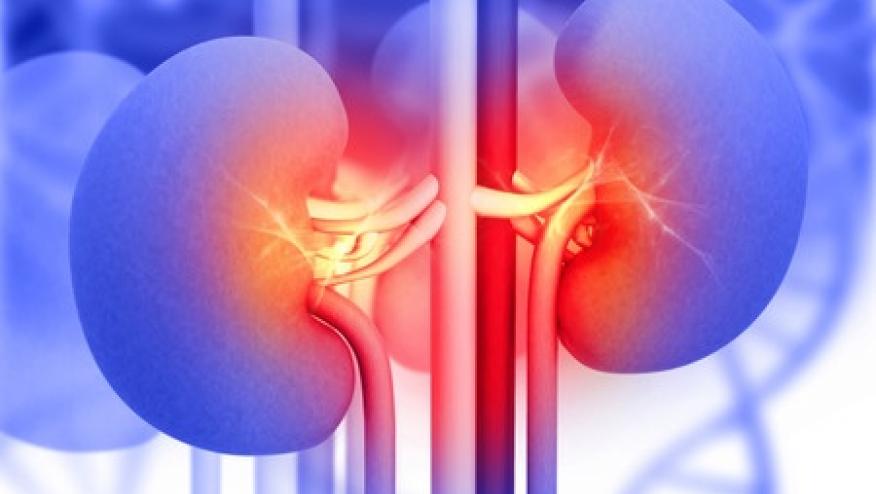Kidney Dysfunction Frequent in RA Save

Renal dysfunction is common among patients with rheumatoid arthritis (RA), particularly among older patients, women, and those with hypertension, Japanese researchers reported.
Using absolute estimated glomerular filtration rates (eGFR), 33.8% of patients had renal dysfunction, according to Shunsuke Mori, MD, of Kumamoto Saishunsou National Hospital in Kohshi, and colleagues.
And in a multivariate analysis, the odds ratios for renal dysfunction were 7.24 (95% CI 5.71-9.18, P<0.001) for age over 65, 3.12 for female gender (95% CI 2.29-4.24, P<0.001), and 2.22 for hypertension (95% CI 1.76-2.80, P<0.001), the researchers reported in Clinical Rheumatology.
The researchers stressed, however, that these analyses relied on the absolute eGFR, rather than a body surface area-indexed eGFR. According to the absolute eGFR, renal dysfunction was defined as less than 60 mL/min, while the body surface area-adjusted eGFR was less than 60 mL/min/1.732. The researchers pointed out that the body surface area-adjusted eGFR can be misleading in patients who are either obese or very lean, and in this study the mean body surface area was 1.52 m2 rather than 1.73 m2.
Earlier studies describing biopsy and clinical renal findings in patients with RA suggested that the dominant manifestations were secondary amyloidosis, membranous nephropathy, mesangial glomerulonephritis, and vasculitis. However, those studies were based on patients being treated with older antirheumatic drugs such as gold and penicillamine, which have been associated with nephrotoxicity, and secondary amyloidosis is now uncommon because of improved RA treatment.
Nonetheless, renal involvement in RA may be increasing despite modern treatments, and may be contributing to RA patients' persistently increased mortality.
To examine current patterns of renal dysfunction in RA, Mori's group conducted a cross-sectional study, recruiting 1,908 patients from three outpatient centers in Japan during 2014 and 2015. For each patient, they collected demographic characteristics, RA disease features such as duration, disease activity, and seropositivity, medication use, and traditional cardiovascular risk factors such as hypertension and diabetes.
Using the absolute eGFR cutoff, characteristics of patients with renal dysfunction included greater age, with more than half of individuals older than 70 being affected, and female sex.
When body surface area-indexed eGFR was used, the prevalence of renal dysfunction was much lower than with the absolute eGFR, at 18.6%, which is comparable with the frequency in the overall Japanese population.
With the absolute eGFR calculation, patients with renal dysfunction were older than those without dysfunction (72 versus 58.8 years, P<0.001), had longer duration of RA (12 versus 10.1 years, P<0.001), and more often had high disability classification (52.7 versus 45.2, P=0.002). They also had higher scores on the Health Assessment Questionnaire (HAQ; 0.56 versus 0.35, P<0.001).
Hypertension and diabetes were observed more often among those with renal dysfunction, but obesity was less common. Women more often had renal dysfunction.
With the body surface area-indexed eGFR, renal dysfunction was again associated with older age (73.1 versus 61, P<0.001), though not with gender. Disease duration, higher HAQ scores, hypertension, and diabetes also were associated with renal dysfunction.
A total of 51.6% of patients were receiving methotrexate, and 33.6% were being treated with biologics. Methotrexate was used less often among patients with renal dysfunction calculated according to both absolute eGFR (43.6% versus 55.7%, P<0.001) and body surface area-indexed eGFR (39.4% versus 54.3%, P<0.001). Biologics were more often used among patients with renal dysfunction according to the absolute eGFR, while steroids were more often given to those with renal dysfunction according to the body surface area-indexed eGFR.
On the multivariate analyses, obesity was negatively associated with renal dysfunction according to the absolute eGFR.
With the body surface area-indexed eGFR, independent associations were seen for age over 65 (OR 5.19, 95% CI 3.83-7.05, P<0.001) and hypertension (OR 3.05, 95% CI 2.37-3.96, P<0.001). Statistically significant associations were not seen according to this calculation for female gender.
"Considering that RA patients, especially elderly individuals, are likely to present a smaller body size than 1.73 m2, it would be better to consider using absolute eGFR instead of body surface area-indexed eGFR in studies for RA patients," the researchers argued.
Regular monitoring of renal function is advisable in patients with RA, so that early intervention can help prevent kidney complications, they concluded.
A limitation of the study was its cross-sectional design, so causality cannot be inferred.
The study was supported by the National Hospital Organization of Japan.
Mori and co-authors disclosed no relevant relationships with industry.










If you are a health practitioner, you may Login/Register to comment.
Due to the nature of these comment forums, only health practitioners are allowed to comment at this time.